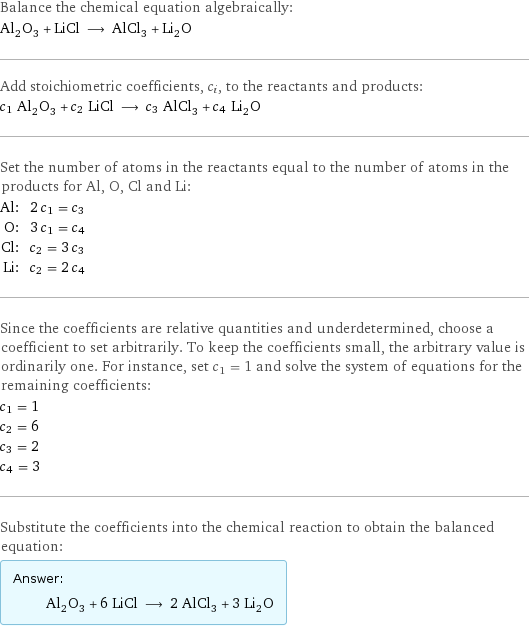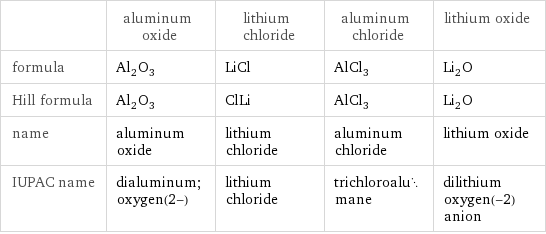Input interpretation

Al_2O_3 aluminum oxide + LiCl lithium chloride ⟶ AlCl_3 aluminum chloride + Li_2O lithium oxide
Balanced equation

Balance the chemical equation algebraically: Al_2O_3 + LiCl ⟶ AlCl_3 + Li_2O Add stoichiometric coefficients, c_i, to the reactants and products: c_1 Al_2O_3 + c_2 LiCl ⟶ c_3 AlCl_3 + c_4 Li_2O Set the number of atoms in the reactants equal to the number of atoms in the products for Al, O, Cl and Li: Al: | 2 c_1 = c_3 O: | 3 c_1 = c_4 Cl: | c_2 = 3 c_3 Li: | c_2 = 2 c_4 Since the coefficients are relative quantities and underdetermined, choose a coefficient to set arbitrarily. To keep the coefficients small, the arbitrary value is ordinarily one. For instance, set c_1 = 1 and solve the system of equations for the remaining coefficients: c_1 = 1 c_2 = 6 c_3 = 2 c_4 = 3 Substitute the coefficients into the chemical reaction to obtain the balanced equation: Answer: | | Al_2O_3 + 6 LiCl ⟶ 2 AlCl_3 + 3 Li_2O
Structures

+ ⟶ +
Names

aluminum oxide + lithium chloride ⟶ aluminum chloride + lithium oxide
Equilibrium constant
![Construct the equilibrium constant, K, expression for: Al_2O_3 + LiCl ⟶ AlCl_3 + Li_2O Plan: • Balance the chemical equation. • Determine the stoichiometric numbers. • Assemble the activity expression for each chemical species. • Use the activity expressions to build the equilibrium constant expression. Write the balanced chemical equation: Al_2O_3 + 6 LiCl ⟶ 2 AlCl_3 + 3 Li_2O Assign stoichiometric numbers, ν_i, using the stoichiometric coefficients, c_i, from the balanced chemical equation in the following manner: ν_i = -c_i for reactants and ν_i = c_i for products: chemical species | c_i | ν_i Al_2O_3 | 1 | -1 LiCl | 6 | -6 AlCl_3 | 2 | 2 Li_2O | 3 | 3 Assemble the activity expressions accounting for the state of matter and ν_i: chemical species | c_i | ν_i | activity expression Al_2O_3 | 1 | -1 | ([Al2O3])^(-1) LiCl | 6 | -6 | ([LiCl])^(-6) AlCl_3 | 2 | 2 | ([AlCl3])^2 Li_2O | 3 | 3 | ([Li2O])^3 The equilibrium constant symbol in the concentration basis is: K_c Mulitply the activity expressions to arrive at the K_c expression: Answer: | | K_c = ([Al2O3])^(-1) ([LiCl])^(-6) ([AlCl3])^2 ([Li2O])^3 = (([AlCl3])^2 ([Li2O])^3)/([Al2O3] ([LiCl])^6)](../image_source/8cf95bee7e19c197cf207e604793e5bc.png)
Construct the equilibrium constant, K, expression for: Al_2O_3 + LiCl ⟶ AlCl_3 + Li_2O Plan: • Balance the chemical equation. • Determine the stoichiometric numbers. • Assemble the activity expression for each chemical species. • Use the activity expressions to build the equilibrium constant expression. Write the balanced chemical equation: Al_2O_3 + 6 LiCl ⟶ 2 AlCl_3 + 3 Li_2O Assign stoichiometric numbers, ν_i, using the stoichiometric coefficients, c_i, from the balanced chemical equation in the following manner: ν_i = -c_i for reactants and ν_i = c_i for products: chemical species | c_i | ν_i Al_2O_3 | 1 | -1 LiCl | 6 | -6 AlCl_3 | 2 | 2 Li_2O | 3 | 3 Assemble the activity expressions accounting for the state of matter and ν_i: chemical species | c_i | ν_i | activity expression Al_2O_3 | 1 | -1 | ([Al2O3])^(-1) LiCl | 6 | -6 | ([LiCl])^(-6) AlCl_3 | 2 | 2 | ([AlCl3])^2 Li_2O | 3 | 3 | ([Li2O])^3 The equilibrium constant symbol in the concentration basis is: K_c Mulitply the activity expressions to arrive at the K_c expression: Answer: | | K_c = ([Al2O3])^(-1) ([LiCl])^(-6) ([AlCl3])^2 ([Li2O])^3 = (([AlCl3])^2 ([Li2O])^3)/([Al2O3] ([LiCl])^6)
Rate of reaction
![Construct the rate of reaction expression for: Al_2O_3 + LiCl ⟶ AlCl_3 + Li_2O Plan: • Balance the chemical equation. • Determine the stoichiometric numbers. • Assemble the rate term for each chemical species. • Write the rate of reaction expression. Write the balanced chemical equation: Al_2O_3 + 6 LiCl ⟶ 2 AlCl_3 + 3 Li_2O Assign stoichiometric numbers, ν_i, using the stoichiometric coefficients, c_i, from the balanced chemical equation in the following manner: ν_i = -c_i for reactants and ν_i = c_i for products: chemical species | c_i | ν_i Al_2O_3 | 1 | -1 LiCl | 6 | -6 AlCl_3 | 2 | 2 Li_2O | 3 | 3 The rate term for each chemical species, B_i, is 1/ν_i(Δ[B_i])/(Δt) where [B_i] is the amount concentration and t is time: chemical species | c_i | ν_i | rate term Al_2O_3 | 1 | -1 | -(Δ[Al2O3])/(Δt) LiCl | 6 | -6 | -1/6 (Δ[LiCl])/(Δt) AlCl_3 | 2 | 2 | 1/2 (Δ[AlCl3])/(Δt) Li_2O | 3 | 3 | 1/3 (Δ[Li2O])/(Δt) (for infinitesimal rate of change, replace Δ with d) Set the rate terms equal to each other to arrive at the rate expression: Answer: | | rate = -(Δ[Al2O3])/(Δt) = -1/6 (Δ[LiCl])/(Δt) = 1/2 (Δ[AlCl3])/(Δt) = 1/3 (Δ[Li2O])/(Δt) (assuming constant volume and no accumulation of intermediates or side products)](../image_source/b01cb2e5f77157c134593b4fe4cd56fd.png)
Construct the rate of reaction expression for: Al_2O_3 + LiCl ⟶ AlCl_3 + Li_2O Plan: • Balance the chemical equation. • Determine the stoichiometric numbers. • Assemble the rate term for each chemical species. • Write the rate of reaction expression. Write the balanced chemical equation: Al_2O_3 + 6 LiCl ⟶ 2 AlCl_3 + 3 Li_2O Assign stoichiometric numbers, ν_i, using the stoichiometric coefficients, c_i, from the balanced chemical equation in the following manner: ν_i = -c_i for reactants and ν_i = c_i for products: chemical species | c_i | ν_i Al_2O_3 | 1 | -1 LiCl | 6 | -6 AlCl_3 | 2 | 2 Li_2O | 3 | 3 The rate term for each chemical species, B_i, is 1/ν_i(Δ[B_i])/(Δt) where [B_i] is the amount concentration and t is time: chemical species | c_i | ν_i | rate term Al_2O_3 | 1 | -1 | -(Δ[Al2O3])/(Δt) LiCl | 6 | -6 | -1/6 (Δ[LiCl])/(Δt) AlCl_3 | 2 | 2 | 1/2 (Δ[AlCl3])/(Δt) Li_2O | 3 | 3 | 1/3 (Δ[Li2O])/(Δt) (for infinitesimal rate of change, replace Δ with d) Set the rate terms equal to each other to arrive at the rate expression: Answer: | | rate = -(Δ[Al2O3])/(Δt) = -1/6 (Δ[LiCl])/(Δt) = 1/2 (Δ[AlCl3])/(Δt) = 1/3 (Δ[Li2O])/(Δt) (assuming constant volume and no accumulation of intermediates or side products)
Chemical names and formulas

| aluminum oxide | lithium chloride | aluminum chloride | lithium oxide formula | Al_2O_3 | LiCl | AlCl_3 | Li_2O Hill formula | Al_2O_3 | ClLi | AlCl_3 | Li_2O name | aluminum oxide | lithium chloride | aluminum chloride | lithium oxide IUPAC name | dialuminum;oxygen(2-) | lithium chloride | trichloroalumane | dilithium oxygen(-2) anion
Substance properties

| aluminum oxide | lithium chloride | aluminum chloride | lithium oxide molar mass | 101.96 g/mol | 42.4 g/mol | 133.3 g/mol | 29.9 g/mol phase | solid (at STP) | solid (at STP) | solid (at STP) | melting point | 2040 °C | 605 °C | 190 °C | boiling point | | 1382 °C | | density | | 2.07 g/cm^3 | | 2.013 g/cm^3 dynamic viscosity | | 0.00525 Pa s (at 20 °C) | | odor | odorless | | |
Units
